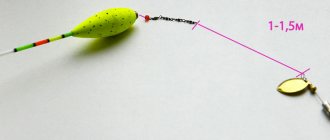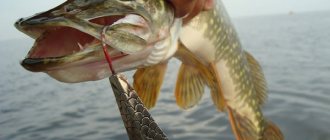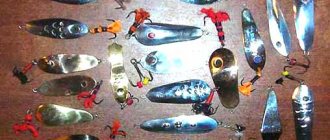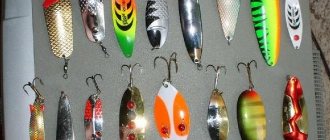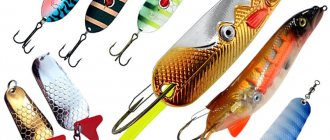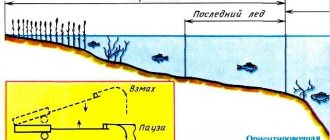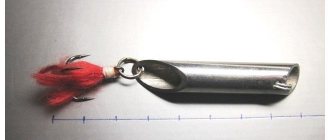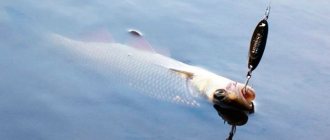Why have many fishermen lost interest in them? Are they really that bad? Should we forget about them?
I have been collecting Soviet-made spinner spoons for a long time, and I test each one using a specially developed system, calculating the actual catchability. Why do this when my boxes are full of excellent wobblers and full of working rubber? Yes, because the Soviet spinner is a resurgent brand, implying very catchy and expensive baits.
However, the price does not matter much for connoisseurs of the classics. Auctions are held on the Internet, where original Soviet spoons sell like hot cakes at a price comparable to an excellent modern wobbler. And these baits are bought in the desire to pay tribute to the masters of the past, who proved that the price of a bait is not an indicator of its catchability.
Decreased interest in vibrations
After the collapse of the USSR, interest in oscillators began to decline. With the advent of rubber, many spinning anglers switched to it, considering it more catchy and better adapted to a wide variety of lake and river fishing conditions. And with the advent of fashion for wobblers, modern spinning rods turned away from spinners altogether. This was largely due to the dominance of low-quality spinners that appeared on sale. For many, the spinner has become some kind of crappy bait, which is more or less suitable only for catching autumn pike. The situation was slightly improved by the appearance of modern Scandinavian, American, Canadian, and Japanese spinners, raising the prestige of the spinner as such. But there were big problems with the purchase of these deceptions in small towns and villages, and they still remain. In general, there is nothing good in the modern assortment of spinners in many stores; you want to buy some kind of spoon, but everything is just “China”. But the Chinese somehow make the vibrators incorrectly, some “for children”, and they rust over time. I won’t say that all iron spoons are bad, and only brass is good, but it’s definitely not good for a spoon to rust.
In general, Soviet spinners remained the most popular bait for a long time; they served spinning rods well for several decades. And their authority was very high until the mid-90s, after which they were valued only by ardent fans of hardware.
Types of pike spoons and their features
In the modern world there is a wide variety of lures for pike, but real fishermen always have a spinner in their arsenal, since pike are caught with it all year round.
Spoons for pike are divided into two main classes:
- Oscillating spinners.
- Rotating spinners.
Oscillating spoons or short oscillators are made of a metal plate in a slightly curved form, and when inserted, they begin to waddle, move from side to side, in a word, oscillate, hence their name. Oscillating spoons are popular because they have a number of advantages:
- universal spinner. You can use it both in calm bodies of water and in strong currents;
- used in hard to reach places. The spoons provide little resistance, as they have the shape of a curved plate, so you can catch pike with it even in the most inaccessible places;
- ease of use. Using this spinner, you don’t need any skills, you just need to throw the spinning rod and pull it towards you, the spinner itself will begin to “play” in the water.
Rating of oscillating lures for pike in the video below:
A spinner or simply a spinner consists of a wire rod, a metal petal, which rotates around the center (rod) when retrieved, and a treble hook. Turntables also have several advantages:
- ease of use. Even a beginner can handle such a spinner; no knowledge is needed;
- vibrations created. The appearance of the spoons is not similar to any other fish, therefore it is the vibrations created that attract the pike.
Photo: Spoons for pike and their varieties
The current return of interest in Soviet products is a natural phenomenon
All types of modern baits have been mastered. The advertisement sang one thing, but life puts everything in its place - all types of baits are equivalent in terms of catchability in the conditions where they are appropriate. If we compare the catchability of a spinner and a modern wobbler, I am convinced that the spinner catches no worse.
And if Soviet spinners were so bad, then modern manufacturers would not stick to them. Soviet spinners include all models produced before 1992. During this period and further, right up to the present day, the market was flooded with an incredible number of Chinese and Russian-made baits, with names from the legendary Soviet spinners. But for the most part they have nothing to do with them, differing significantly from the original, and mostly for the worse.
Are Soviet spinners really that bad?
Why have many fishermen lost interest in them? Are they really that bad? Should we forget about them?
I have been collecting Soviet-made spinner spoons for a long time, and I test each one using a specially developed system, calculating the actual catchability. Why do this when my boxes are full of excellent wobblers and full of working rubber? Yes, because the Soviet spinner is a resurgent brand, implying very catchy and expensive baits.
However, the price does not matter much for connoisseurs of the classics. Auctions are held on the Internet, where original Soviet spoons sell like hot cakes at a price comparable to an excellent modern wobbler. And these baits are bought in the desire to pay tribute to the masters of the past, who proved that the price of a bait is not an indicator of its catchability.
Soviet spinners are also not all of high quality
If the winding rings were often normal, then the poor quality of the tees was the order of the day. But this is a removable part of the spoon, and can be easily replaced with a higher-quality modern tee. Much more significant is that the spinners themselves varied greatly. Many models were made from cheap iron, which began to rust even under a protective coating, especially Ukrainian models - Zhytomyr, Kyiv.
Lures were made using the usual stamping method, and, apparently, this was not always normal equipment, they did not always work on it conscientiously, and one batch of lures often had defects - differences in weight, flaws in metal processing. As a result, there are two outwardly similar deceptions, but one successfully catches a predator, and the other is a useless piece of metal.
Advantages and disadvantages
If we talk about Soviet spinners, it makes sense to consider only spinners produced before the time of perestroika, since now there are a huge number of baits bearing the name of the legendary Soviet spinners, but produced not only in our country, but also in Asian countries and the countries of the former USSR, and at the same time having properties different from the originals.
The advantages of Soviet spinners were the following:
- low and even low cost;
- good catchability;
- the opportunity to find a spoon for catching different types of fish in different conditions.
But Soviet spinners were not without shortcomings, the most noticeable of which were the following:
- low quality fittings and triple hooks. Experienced fishermen remember Kolyubaka tees, in which the barb on one of the hooks was not on the inside of the hook, but on the outside. The hooks were initially blunt, and during the fishing process they required constant sharpening and quickly rusted;
- non-compliance of spinners of one name with the standard. In the batch of spinners, deviations in weight, flaws in metal processing and other defects were observed. Therefore, seemingly identical spoons could either successfully catch fish or be simply a useless piece of metal.
The spinners were also designed differently
Someone took world-famous spinners as a model and, with varying degrees of success, riveted replicas, giving them their own names. Someone created truly original spinners, without the usual 3D modeling for today's practice, but making the bait on a whim, often from tips from the experience of Soviet spinners. That is, even then the baits were created by different people who understood well what they were doing; and amateurs who are far from real fishing.
As a result, many models of Soviet spinners fell into oblivion due to their almost zero catchability. And I haven’t heard that even collectors are chasing them - why collect junk that is not able to catch fish? But the excellent lures remain, and interest in them is only growing. After all, this is both our glorious history of spinning and simply high efficiency. And I am not at all surprised by the excitement that has arisen in recent years around Soviet spinners when catching large perch and pike.
How to make a lure for pike with your own hands
They started making pike lures on their own back in the USSR; the manufacturing process was not hidden from anyone, but on the contrary, skills and abilities were shared. All these ideas have reached us, so now we will share with you the secret of how to make a spinner yourself.
To make a spinner you will need:
- tablespoon;
- file;
- hammer;
- nail;
- hook;
- winding rings.
Once we have prepared all the tools, we begin manufacturing:
- It is necessary to cut off the handle of the spoon.
- Next, we process the cut area with a file.
- We drill small holes along the edges on both sides.
- Now we install the hook in one of the holes, and the winding rings in the other.
That's all, our spoon bait is ready. Many spinning anglers praise these homemade pike spoons for good catching of prey. The entire manufacturing process is shown in more detail in the video below:
The most important thing in pike fishing is the right choice of spoon. If you want to return home with your catch, thoroughly study the types of spoons, choose the right spoon for fishing, taking into account all the nuances that we have discussed with you. Have a nice catch everyone. And as they say, no tail, no scales!
Views: 14,916
Lure test according to the Olympic system
I have already collected a lot of working spinners from the times of the USSR. And I’m trying to catch everything, thoroughly testing, trying to be as objective as possible. Test according to the Olympic system - the weak one is eliminated. That is, I arrange competitions between baits and each other, the main arbiter is a predator, and I am, as it were, a demanding fan.
To exclude the possibility of chance, I test baits for quite a long time, about two years, and each spoon works in different bodies of water. Initially, I divided all the baits into groups, forming them in a random order - as the hand lays. On a particular fishing trip, each bait makes about 10-15 retrieves, then changes. On my next fishing trip on a different body of water, I again make a dozen casts each. And so in a circle, fishing after fishing, season after season. After a couple of years, favorites and outsiders are calculated. The latter are sent to the “archive”. And those who distinguished themselves gather in their own groups, where they begin to compete with each other. Typically, any bait works well only in certain conditions, and to understand this, you need to experiment a lot and record the results of each bait.
The weight range of my “iron” is from 4 to 55 g. The most universal ones are from 14 to 20 g, with which you can fish the entire water area on deep lakes and rivers. But what is universal is not the best thing, and that’s certainly true in vibrators. With a super-heavy spoon, you can really fish the pit dumps very thoroughly, no worse than with a jig. And lighter, wider spoons are very good for fishing in overgrown shallow waters, in no way inferior to twitching wobblers.
I don’t immediately reject any new bait that comes into my arsenal. Only after thoroughly testing do I come to a conclusion. At the same time, I cannot understand why lures that are largely similar, both in game and in size, selectively affect pike of different sizes. Let's say, one model perfectly collects fish up to 2-3 kg, and a large pike turns up its nose at it, no matter what kind of wiring you offer. And the other spoon catches small pike well, and clearly attracts specimens weighing 3-5 kg. There is also a small spoon (one side is copper, the other is steel), I don’t know how it is made, but the perch sits on it very actively, and the pike completely ignores it.
History of the creation of the cicada
Among the variety of artificial baits for spinning fishing, cicadas occupy a special place. These spoons are radically different from the usual spinners, spinners and wobblers. Cicada is famous for its high efficiency and versatility.
With the help of this spoon, anglers catch predators with equal success using a spinning rod or winter gear. But in order to feel the bite of a large predator, you need to carefully equip the tackle and accurately present the bait.
In 1957, a new artificial bait was introduced to the fishing public in America. Its creator was the famous developer James Haddon.
The new spinner has received several names, for example, “bladebait”, “blade”, “metal vibe”. But most often the new development was called a cicada . The declassified sample was a flat piece of metal that created strong vibrations in water.
American spinning anglers greeted the new product rather coolly and soon forgot about it. However, years later, when previously popular spinning baits no longer met the needs of fishermen, they remembered the cicada. The spinner has received a new life, eclipsing most of the existing baits. In some states, authorities have decided to ban the use of cicadas due to their high catchability.
“Bladebaits” appeared in the vastness of Russia not so long ago. And they immediately came under the gun of professional spinning players. First of all, the cicada was liked by such predatory fish as perch and pike perch. However, gradually the bait was “tasted” by pike, catfish and even asp.
After numerous tests, fishing experts came to a simple conclusion. The bait allows the spinner to experiment while retrieving, then different predators will be interested in the cicada.
A compact spinner, armed with a pair of doubles, maintains a stable position when retrieved. This makes the cicada irresistible to predatory fish. The fisherman only needs to choose the right weight of the bait so that it occupies a certain horizon in the water.
The versatility of the development lies in the fact that it allows you to fish water areas with a depth of 1 to 20 m.
